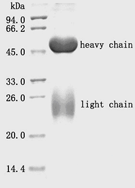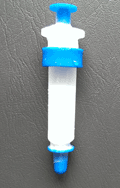|
LT12014 |
|
1 mL resin, crosslinked 6% beaded agarose supplied as 50% slurry (e.g., 1mL of settled resin is equivalent to 2mL of 50% slurry) in 0.02% sodium azide |
|
10~20 mg/ml rabbit IgG or 15~25 mg/ml human IgG |
|
2-11 (short term); 3-10 (long term) |
|
45 to 165 microns |
| 10,000 to 4,000,000 daltons |
Maximum Volumetric Flow Rate: |
approx. 1mL/minute (for 1cm diameter column); Maximum Linear Velocity: 30cm per hour;
Maximum Pressure: less than 4.5psi (0.3 bar) |
|
4 °C - 8 °C in 20% ethanol |
| 3 years |
| LifeTein Protein A Agarose is an alkali-tolerant Protein A Agarose that has been covalently immobilized onto 6% beaded agarose. The high binding Protein A agarose resin can be used for antibody affinity purificaiton. The immobilized Protein A is used for polyclonal IgG purification from rabbit, human, dog or cat serum.
Highlights:
- Alkali tolerant: Improved alkaline resistance. NaOH can be used to regenerate resin.
- High Binding Capacity: The high binding capacity of 10-20 mg/ml IgG to Protein A is perfect for batch- or column- type affinity purification.
- Stability: Specially designed sepharose linked to recombinant alkali-tolerant Protein A with spacer arms for improved stability and binding capability.
Binding buffer: 20 mM sodium phosphate, 150 mM NaCl, pH 7.4
Elution buffer: 100 mM sodium citrate, pH 3.0
Neutralization buffer: 1M citrate buffer, pH 9.0
- Wash the prepacked column with 5~10 column volumes of distilled water to remove 20% ethanol.
- Equilibrate the column with 5~10 column volumes of binding buffer.
- 1:10 dilution of serum with binding buffer. Filtrate the diluted serum through a 0.45 μm filter and load the sample.
- Wash with 10 column volumes of binding buffer.
- Elute with 5 column volumes of elution buffer and neutralize collect fractions with neutralization buffer.
- After each separation cycle, regenerate the resin by washing with approximately 3~5 column volumes of
0.1 M citrate buffer (pH 3.0).
- Confirm the purity of the collected antibody by SDS-PAGE analysis.
- Purification capacity: ≥30 mg of rabbit IgG per ml of recombinant protein A agarose gel.
 
|
Typical binding and elution conditions with protein A Agarose |
Species |
Antibody Class |
Protein A binding |
pH value of binding buffer |
pH value of elution buffer |
Human |
IgG1 |
++ |
6.0~7.0 |
3.5~4.5 |
IgG2 |
++ |
6.0~7.0 |
3.5~4.5 |
IgG3 |
- |
8.0~9.0 |
<7.0 |
IgG4 |
++ |
7.0~8.0 |
2.5~4.5 |
Cow |
IgG2 |
++ |
|
2 |
Goat |
IgG2 |
+ |
|
5.8 |
Mouse |
IgG1 |
+ |
8.0~9.0 |
5.5~7.5 |
IgG2a |
+ |
7.0~8.0 |
4.5~5.5 |
IgG2b |
+ |
7.0 |
3.5~4.5 |
IgG3 |
+ |
7.0 |
4.0~7.0 |
Rat |
IgG1 |
+ |
>9.0 |
7.0~8.0 |
IgG2a |
- |
>9.0 |
<8.0 |
IgG2b |
- |
>9.0 |
<8.0 |
IgG3 |
+ |
8.0~9.0 |
3.0~4.0 |
Rabbit |
no distinction |
++++ |
7.4 |
3.5~4.5 |
|
|
- Avoid air bubbles.
- Regenerate the resin every 5 purification in order to maintain the product efficiency.
- After every 10 separation cycle, wash the resin with 5 column volumes of 20% ethanol and 5~10 column volumes of 70% ethanol sequentially to remove hydrophobic substances.
- Keep at 4~8 °C in 20% ethanol.
|
| For research use only! |
 https://www.lifetein.com
100 Randolph Road, Suite 2D,
Somerset
USA
New Jersey
08873
https://www.lifetein.com
100 Randolph Road, Suite 2D,
Somerset
USA
New Jersey
08873
 https://www.lifetein.com
100 Randolph Road, Suite 2D,
Somerset
USA
New Jersey
08873
https://www.lifetein.com
100 Randolph Road, Suite 2D,
Somerset
USA
New Jersey
08873